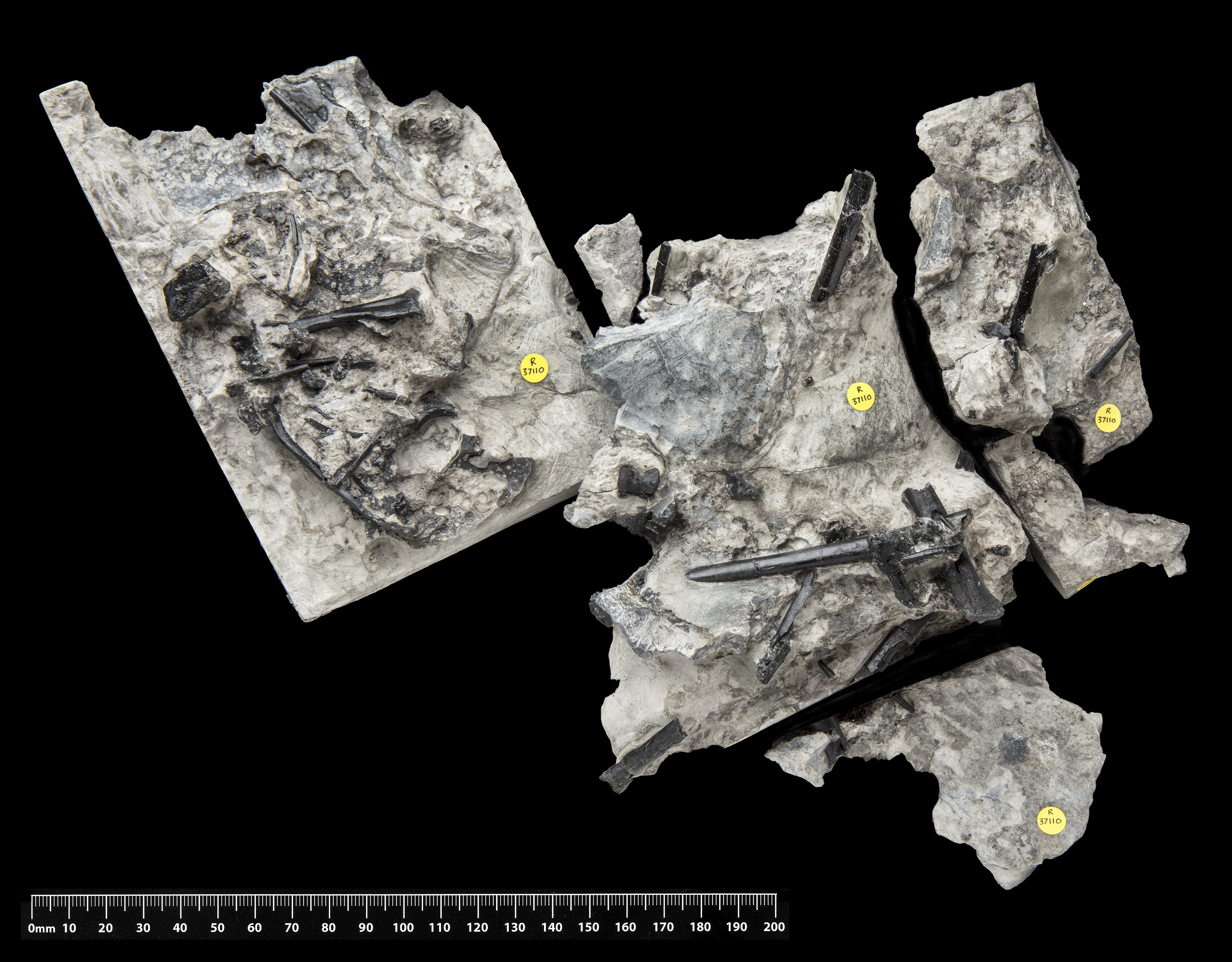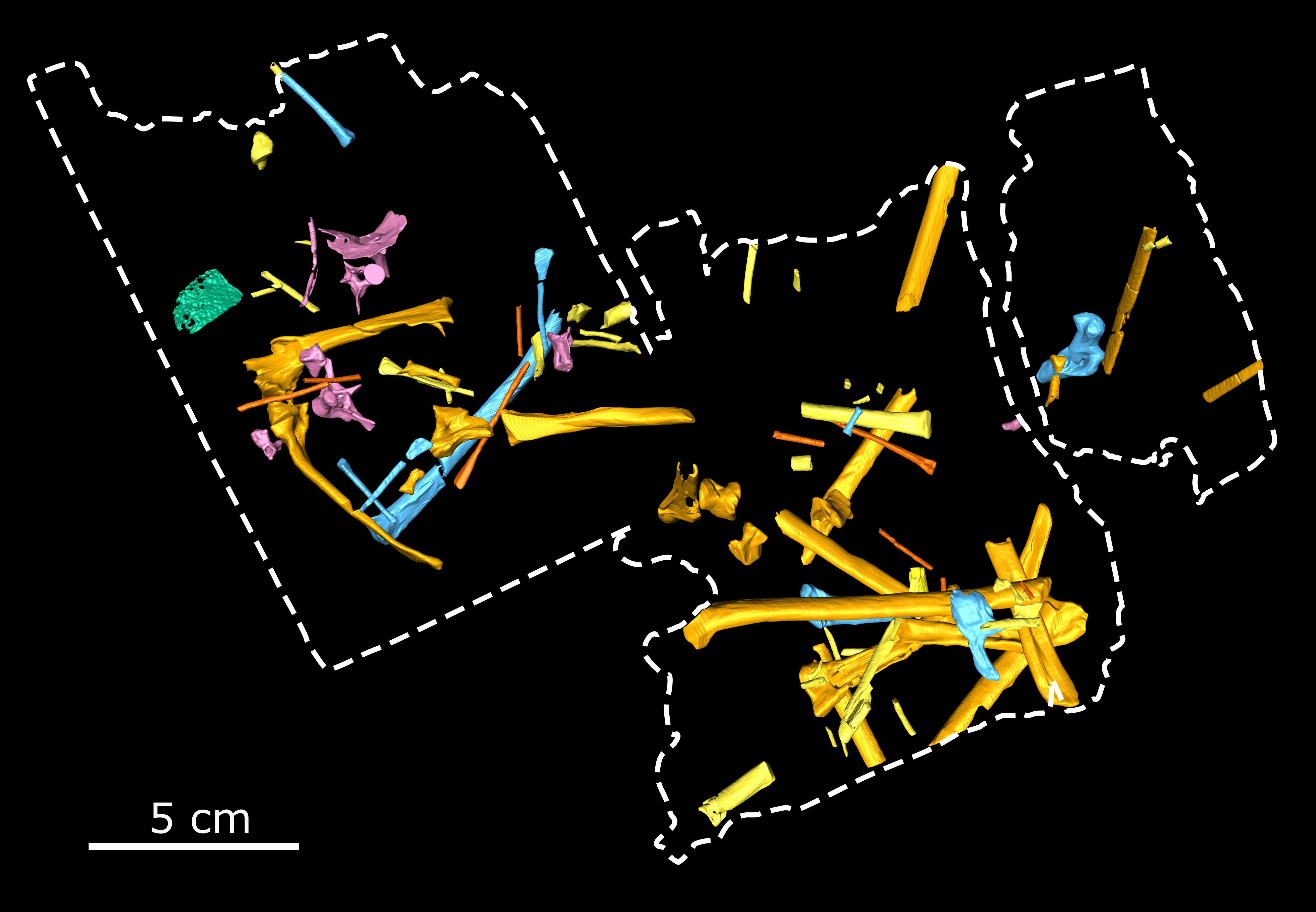
Scientists have discovered a new species of pterosaur on the Isle of Skye in Scotland.
Named Ceoptera evansae, the winged reptile lived between 168 to 166 million years ago during the Middle Jurassic period.
Palaeontologists spotted the fossil remains in 2006 during a field trip to Elgol, on the south-west coast of the island.
READ MORE: Walking in the footsteps of dinosaurs on Skye: the secrets of Scotland's Jurassic isle
Since then, the team has spent years physically preparing the specimen and taking scans of the bones, some of which remain completely embedded in rock.
Pterosaurs are considered cousins to the dinosaurs they lived alongside, having branched out on the evolutionary tree to become their own species.
Despite the skeleton being incomplete – with only parts of the shoulders, wings, legs and backbone remaining – the researchers said it provides key insights into the evolutionary history and diversity of pterosaurs.
 The skeleton of the new pterosaur, Ceoptera evansae, from the Middle Jurassic period was discovered on the Isle of Skye (Trustees of the Natural History Museum London/PA)
The skeleton of the new pterosaur, Ceoptera evansae, from the Middle Jurassic period was discovered on the Isle of Skye (Trustees of the Natural History Museum London/PA)
They said the new species belongs to a group of pterosaurs known as Darwinoptera, with many fossils also found in China.
Findings, published in the Journal Of Vertebrate Paleontology, suggest Darwinoptera may have been considerably more diverse than previously thought, persisting for more than 25 million years.
Professor Paul Barrett, merit researcher at the Natural History Museum, said: “Ceoptera helps to narrow down the timing of several major events in the evolution of flying reptiles.
“Its appearance in the Middle Jurassic of the UK was a complete surprise, as most of its close relatives are from China.
“It shows that the advanced group of flying reptiles to which it belongs appeared earlier than we thought and quickly gained an almost worldwide distribution.”
READ MORE: Police probe damage to dinosaur footprints on Skye beach
Ceoptera evansae gets the first part of its name from the Scottish gaelic word “cheo”, meaning mist or fog, and the Latin word “ptera”, meaning wing.
The second part, evansae, honours British palaeontologist Professor Susan E Evans for her years of scientific work, particularly on the Isle of Skye.
As the Elgol coastal site is classed as a Site of Special Scientific Interest, the team led by Prof Barrett could only collect specimens from rocks that had fallen on to the beach.
 A 3D model of the skeleton of Ceoptera evansae (Martin-Silverstone et al/Journal of Vertebrate Paleontology/PA)
A 3D model of the skeleton of Ceoptera evansae (Martin-Silverstone et al/Journal of Vertebrate Paleontology/PA)
But while crawling over boulders to examine these fossils, the researchers noticed a few bones sticking out, which has now been revealed as the new pterosaur.
The researchers said that pterosaur fossils from the Middle Jurassic period are rare and mostly incomplete, hindering attempts to understand more about how these creatures evolved.
READ MORE: Historic town's giant dinosaur head saved from extinction
Lead author Dr Liz Martin-Silverstone, a palaeobiologist from the University of Bristol, said: “The time period that Ceoptera is from is one of the most important periods of pterosaur evolution, and is also one in which we have some of the fewest specimens, indicating its significance.
“To find that there were more bones embedded within the rock, some of which were integral in identifying what kind of pterosaur Ceoptera is, made this an even better find than initially thought.
“It brings us one step closer to understanding where and when the more advanced pterosaurs evolved.”



Why are you making commenting on The Herald only available to subscribers?
It should have been a safe space for informed debate, somewhere for readers to discuss issues around the biggest stories of the day, but all too often the below the line comments on most websites have become bogged down by off-topic discussions and abuse.
heraldscotland.com is tackling this problem by allowing only subscribers to comment.
We are doing this to improve the experience for our loyal readers and we believe it will reduce the ability of trolls and troublemakers, who occasionally find their way onto our site, to abuse our journalists and readers. We also hope it will help the comments section fulfil its promise as a part of Scotland's conversation with itself.
We are lucky at The Herald. We are read by an informed, educated readership who can add their knowledge and insights to our stories.
That is invaluable.
We are making the subscriber-only change to support our valued readers, who tell us they don't want the site cluttered up with irrelevant comments, untruths and abuse.
In the past, the journalist’s job was to collect and distribute information to the audience. Technology means that readers can shape a discussion. We look forward to hearing from you on heraldscotland.com
Comments & Moderation
Readers’ comments: You are personally liable for the content of any comments you upload to this website, so please act responsibly. We do not pre-moderate or monitor readers’ comments appearing on our websites, but we do post-moderate in response to complaints we receive or otherwise when a potential problem comes to our attention. You can make a complaint by using the ‘report this post’ link . We may then apply our discretion under the user terms to amend or delete comments.
Post moderation is undertaken full-time 9am-6pm on weekdays, and on a part-time basis outwith those hours.
Read the rules here